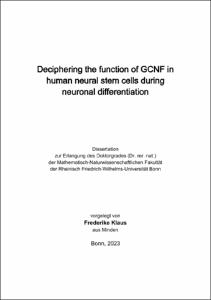Deciphering the function of GCNF in human neural stem cells during neuronal differentiation

Deciphering the function of GCNF in human neural stem cells during neuronal differentiation

| dc.contributor.advisor | Brüstle, Oliver | |
| dc.contributor.author | Klaus, Frederike | |
| dc.date.accessioned | 2023-06-29T13:17:39Z | |
| dc.date.available | 2024-07-01T22:00:25Z | |
| dc.date.issued | 29.06.2023 | |
| dc.identifier.uri | https://hdl.handle.net/20.500.11811/10915 | |
| dc.description.abstract | The human brain is one of the most complex structures described in the biological world and the development of such an intricate organ is tightly regulated by neural stem cell (NSC) proliferation and differentiation. However, the molecular mechanisms regulating these processes are still under investigation.
Different animal studies have suggested a critical role of the orphan nuclear factor and transcriptional repressor GCNF in neural lineage development. In model organisms, GCNF has been associated with the development of definitive NSCs, neural tube closure and correct regionalization. However, not much is known about GCNF’s role in human brain development. This work aimed at deciphering the function of GCNF during human neuronal development using small molecule neural precursor cells (smNPCs) as in vitro model of human NSCs. The spatial and temporal expression pattern of GCNF hinted to an important role of GCNF during neuronal development, since GCNF was expressed in NSCs and the expression was decreasing during neuronal differentiation. The modulation of GCNF expression in smNPCs had a profound effect on smNPC proliferation and differentiation. Overexpression of GCNF increased the proliferation capacity and maintenance of smNPCs at the expense of neuronal differentiation. The knockdown of GCNF had opposite effects, leading to increased numbers of neuronal cells and less proliferative NSCs after 7 days of differentiation. Interestingly, reversing the function of GCNF by fusing the transactivator domain of VP16 to GCNF led to a prominent increase in neuronal cells and an exhaustion of smNPCs. Furthermore, the modulation of GCNF expression also affected smNPC clustering. GCNF overexpression increased the area of the formed cell clusters, while the expression of GCNF-VP16 decreased cluster formation and the area of the formed clusters. Transcriptome microarray analyses were used to understand the molecular mechanisms of the effects of GCNF on smNPC proliferation and neuronal differentiation. Integration of these data with bioinformatic prediction methods was used to identify potential target genes of GCNF. Indeed, BCL11A, a transcriptional repressor involved in murine CNS development, could be confirmed as a direct target gene of GCNF by chromatin immunoprecipitation (ChIP) followed by qRT-PCR. On the translational side, GCNF-VP16 could be employed as tool for accelerated neuronal differentiation of hNSCs with significantly reduced cell cluster formation. Upon GCNF-VP16 expression, smNPCs differentiated into mature neurons displaying similar features as neurons generated by NGN2 overexpression, the gold standard of neuronal forward programming today. Taken together, GCNF was demonstrated to play an important role during human neurogenesis by promoting NSC proliferation, maintenance and cell clustering, while inhibiting neuronal differentiation. These effects might be mediated by BCL11A, a novel target gene of GCNF identified in this study. Exploitation of GCNF-VP16 for rapid and cluster-free neuronal differentiation might provide a versatile tool for setting up high-throughput assays and automated image analyses. | en |
| dc.language.iso | eng | |
| dc.rights | In Copyright | |
| dc.rights.uri | http://rightsstatements.org/vocab/InC/1.0/ | |
| dc.subject.ddc | 500 Naturwissenschaften | |
| dc.subject.ddc | 570 Biowissenschaften, Biologie | |
| dc.title | Deciphering the function of GCNF in human neural stem cells during neuronal differentiation | |
| dc.type | Dissertation oder Habilitation | |
| dc.publisher.name | Universitäts- und Landesbibliothek Bonn | |
| dc.publisher.location | Bonn | |
| dc.rights.accessRights | openAccess | |
| dc.identifier.urn | https://nbn-resolving.org/urn:nbn:de:hbz:5-71191 | |
| ulbbn.pubtype | Erstveröffentlichung | |
| ulbbnediss.affiliation.name | Rheinische Friedrich-Wilhelms-Universität Bonn | |
| ulbbnediss.affiliation.location | Bonn | |
| ulbbnediss.thesis.level | Dissertation | |
| ulbbnediss.dissID | 7119 | |
| ulbbnediss.date.accepted | 26.05.2023 | |
| ulbbnediss.institute | Medizinische Fakultät / Institute : Institut für Rekonstruktive Neurobiologie (IRN) | |
| ulbbnediss.fakultaet | Mathematisch-Naturwissenschaftliche Fakultät | |
| dc.contributor.coReferee | Kolanus, Waldemar | |
| ulbbnediss.date.embargoEndDate | 01.07.2024 |
Dateien zu dieser Ressource
Das Dokument erscheint in:
-
E-Dissertationen (4118)




